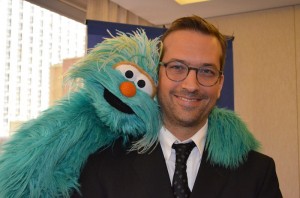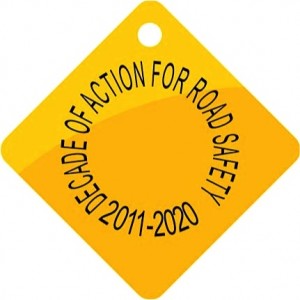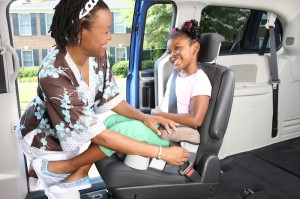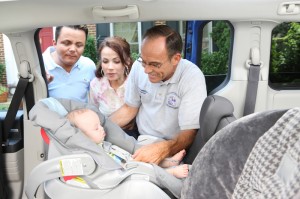23 – Developing Road Safety Awareness For a Lifetime: Teaching them Young

June 26, 2014 | Posted in Global Road Safety, Podcast Episodes | By Traffic Safety Guy
Comments Off on 23 – Developing Road Safety Awareness For a Lifetime: Teaching them Young
Podcast: Play in new window | Download
Subscribe: RSS
Jorge Baxter is the Regional Director in Latin America for Sesame Workshop.[1] With over 15 years in the education, arts, and media fields and extensive experience in leveraging media and education for social change, Mr. Baxter is now raising awareness and educating young children about the deadly issue of traffic crashes. In this episode Mr. Baxter discusses what Sesame Workshop is doing to make an impact on traffic safety: globally, regionally and locally.
Traffic Safety is a Global Issue
- Road traffic crashes take the lives of nearly 1.3 million people every year, with almost half being pedestrians, cyclists and motorcyclists.
- Between 20-50 million people are injured in crashes.
- Road traffic crashes have become a leading cause of death for our youth.
Because of statistics like that, the United Nations declared 2011-20120 the Decade of Action for Road Safety. With a goal of saving 5 million lives by 2020, governments and non-governmental organizations are taking action to change those numbers. Sesame Workshop is one of those organizations.
Joining forces with FIA Foundation and Road Safety Global Partnership, Sesame Workshop is developing educational and advocacy material that is engaging and captures children’s and even parent’s attention. When looking at the issue of traffic safety, Sesame Workshop noted that road crashes disproportionally effect the youth and believes it can make a difference globally because of its educational experience and established contacts.
Starting at a Young Age
When making a decision to get involved, Sesame Workshop examines if there is a compelling reason, and if the issue is one for early childhood. Clearly in this situation, the answer to both questions is a resounding yes. With a dearth of early childhood material on traffic safety, it provided an excellent opportunity to be engaged in the issue.
Children are not born knowing road safety issues, and early interaction can be important. Sesame Workshop’s forte is focusing on children ages 3 to 7 and those individuals in a child’s “circle of influence.” Children learn about their environment from their interaction with adults, so targeting the parents as well as the children is an important part of the process. Real impact happens when children and adults talk about road safety together. It is also important that parents act as a good role model on safety practices, like looking both ways before crossing the road.
Public Service Announcements with Grover
A lot of the material looks at educating young children on such safety issues as:
- Playing near roads
- Pedestrian safety, and
- Bicycle safety and wearing a helmet
To help share the message, Sesame Workshop convinced a well-known celebrity to be a road safety ambassador: Grover, the Muppet. Grover is someone children know and find attractive; and he is curious and adventurous. In the traffic safety PSAs created with Grover, he uses the universal “Thumbs Up” to indicate he is safe and ready to go.
Developing a Localized Message
In developing the message, it was important to recognize that local issues make a difference. What works for a rural area will not work for an urban area and vice versa. There can even be large differences within a country, thus it is important to create material that can be used in local areas.
Partnering with Inter-American Development Bank, FIA Foundation and the Costa Rican government, Sesame Workshop has developed a pilot project for Costa Rica. Using local experts and international research on what works, a tool kit for teachers was created. The kit allows teachers to provide children road safety messages that compliment their current teaching curriculum and daily activities in their own community.
Part of the kit includes a “Big Book” that can be used in different group settings. The Big Book includes a series of stories on road safety along with a DVD of audiovisual content. It even has animations created by Plaza Sesamo[2] incorporated into the messaging. Teachers are also trained on road safety so they understand the issues and how they might teach it. By having children take the road safety message home to their parents, it also encourages parents to learn about the issue. Some common topics include: crossing the road, what road signs and signals mean and pedestrian safety. In this fashion, the teachers, the children, and the parents are all learning about traffic safety.
The Ultimate Goal
Sesame Workshop focuses on having an impact; getting children motivated, changing behavior and ultimately on this issue, saving lives. This tool kit and the PSA messaging will empower children to respect cars, understand the dangers around roads and likewise engage their parents. This way children also become change agents for the adults. With the parents involved, the messages are spread throughout the family and into the community. Finally, children learning about road safety at a young age will be a lesson that can last for a lifetime.
Related Links
Websites:
- FIA Foundation
- Global Road Safety Partnership
- Inter-American Development Bank
- Kidsafe Victoria Australia
- Plaza Sesamo – Road Safety
- Sesame Street – Elmo Stays Safe
- Sesame Workshop
- Sesame Workshop – Road Safety
Research:
Other:
Road Safety Ambassador Grover
Sesame Workshop has appointed Grover as the Road Safety Ambassador as part of the United Nations Decade of Action on Road Safety.
[1] Sesame Workshop is the nonprofit educational organization behind Sesame Street. Established 40 years ago, its mission is to use media to educate children around the world.
[2] Plaza Sesamo is the Spanish-language adaptation of Sesame Street for Latin America.
22 – Child Safety Seats and Booster Seats: A Parental Obligation in Today’s Society

June 16, 2014 | Posted in Child Safety Seats, Podcast Episodes | By Traffic Safety Guy
Comments Off on 22 – Child Safety Seats and Booster Seats: A Parental Obligation in Today’s Society
Podcast: Play in new window | Download
Subscribe: RSS
Children, infants and older, can be the most vulnerable individuals in a car crash. That is why as a parent or grandparent, child safety seats and booster seats are two of the most important things you can purchase for your car.
Deborah Hersman and Traffic Safety
Former NTSB Chairman Deborah Hersman is passionate about having all young children sitting in properly installed child safety seats and booster seats. Before stepping down from the National Transportation Safety Board (NTSB), she and I had the great opportunity to discuss child safety seats and booster seats.[1]
A leading safety advocate, Ms. Hersman provided guidance for the NTSB and the United States on what can be done to make our roads and highways safer. For her, child safety seats are important because they are designed for those individuals who can’t speak for themselves, our children.
Great Advances
The fantastic news is that in her lifetime we have seen tremendous positive change on attitudes about child safety seats. Ms. Hersman discusses briefly about her childhood and sitting in the back seat, without wearing a seat belt, and how that evolution changed because of expectations on military bases where her father was stationed, and now from her understanding of why it is important for everyone to always wear a seat belt. Because of that knowledge, her children were required to sit in child safety seats and then booster seats.
Finding and Using the Right Safety Seat
When buying a child safety seat, parents have a lot of great choices and that’s important because families have different needs. Whether the child is large or small, has physical issues, or the family has multiple children, there are options available. But with those choices comes responsibility.
As a parent, you need to purchase the right seat and then recognize that your child will grow. Just like buying new shoes for your kids, your child will grow out of the seat. It is important to start with a rear-facing seat because that seat will provide the most protection possible for a newborn or infant, and then keep her or him in that rear-facing seat for as long as possible. Then it is onto a forward facing seat. Each step along the way, making sure that the seat fits properly and provides appropriate protection.
Booster Seats are the Next Phase
Once a child grows out of a child safety seat, a parent’s reasonability doesn’t end. At that point, it is time for a booster seat. Booster seats allow children to use seat belts that are designed for adults. The lap belt of a seats belt is supposed to go across the hipbone and shoulder strap across the sternum. But for young children, without that booster seat, the straps can go across the stomach or the neck, which are areas that can create significant harm if in a crash.
A child should not be using a seat belt until she or he is at the right height. Even though many states use age as a determining factor, it is the child’s height that should be determined before moving to seat belts. A parent should examine the length of the child’s femur and determine if the child can sit with his or her back against the car seat and have her or his knees bend comfortably. If the knees don’t break over the seat easily, then the child will slouch, which defeats the whole purpose of a seat belt. Typically, a child should be 57 inches tall. The issue is that most children don’t get to a sufficient height until around age 11, which is beyond the age most states require for booster seat. This is again, where a parent’s responsibility comes into play; keeping your child safe beyond what the law requires.
Is Your Child Safety Seat Installed Correctly?
Buying the child safety seat or booster seat is not the only obligation for a parent—it is also making sure the seat is installed correctly, and that can be challenging. As Ms. Hersman notes, when installing a child seat for one of her children, she and her husband read and followed the instructions. Afterwards, they were confident the seat was installed correctly. While at the NTSB, she became a certified technician to install child safety seats and after two days at the weeklong training, she went home and took the seat out because she learned it was not installed correctly. Even well meaning parents can get it wrong. For her, it highlighted the necessity of having parents allow an expert to examine a child’s seat and determine if the installation is correct. The best part of any inspection is that the vast majority of them are free.
Always Use Your Child Seat
With knowledge comes responsibility and as Ms. Hersman stated, a child’s safety is non-negotiable. With the child safety seat or booster seat purchased and properly installed, it now becomes incumbent to use it—every ride, every time.
Many of today’s parents were not raised using child safety seats or booster seats. However, society’s knowledge and understanding has advanced. We now understand the importance of these life saving products. Learning that we can do something better and safer requires action by all of us. At times it can just take education, at other times it takes action by law enforcement officers. But either way, as parents and grandparents, you can evolve and change your behavior and act for the benefit of those silent voices, keeping your children as safe as possible whenever in a car.
Related Links
Websites:
- National Highway Traffic Safety Administration (NHTSA) Child Safety Seat Recall Sign Up
- National Transportation Safety Board (NTSB)
- NTSB’s Most Wanted List
- Safe Kids Worldwide–Seat Check Sites
- Safer Cars/Parents Central–Child Safety Seats
Research:
Other:
- Graco Recalls 3.8 Million Child Safety Seats
- Highway to Safety Podcast–Jennifer Huebner Davidson–Child Safety Seats: Are Yours Installed Correctly?
- Highway to Safety Podcast–Kate Carr–Child Safety Seats: Buckle Up–Every Ride, Every Time
- Highway to Safety Podcast Videos of Chairman Hersman
Deborah Hersman speaking at a Child Safety Seat Event
[1] Deborah Hersman is now President and CEO for the National Safety Council (NSC).








